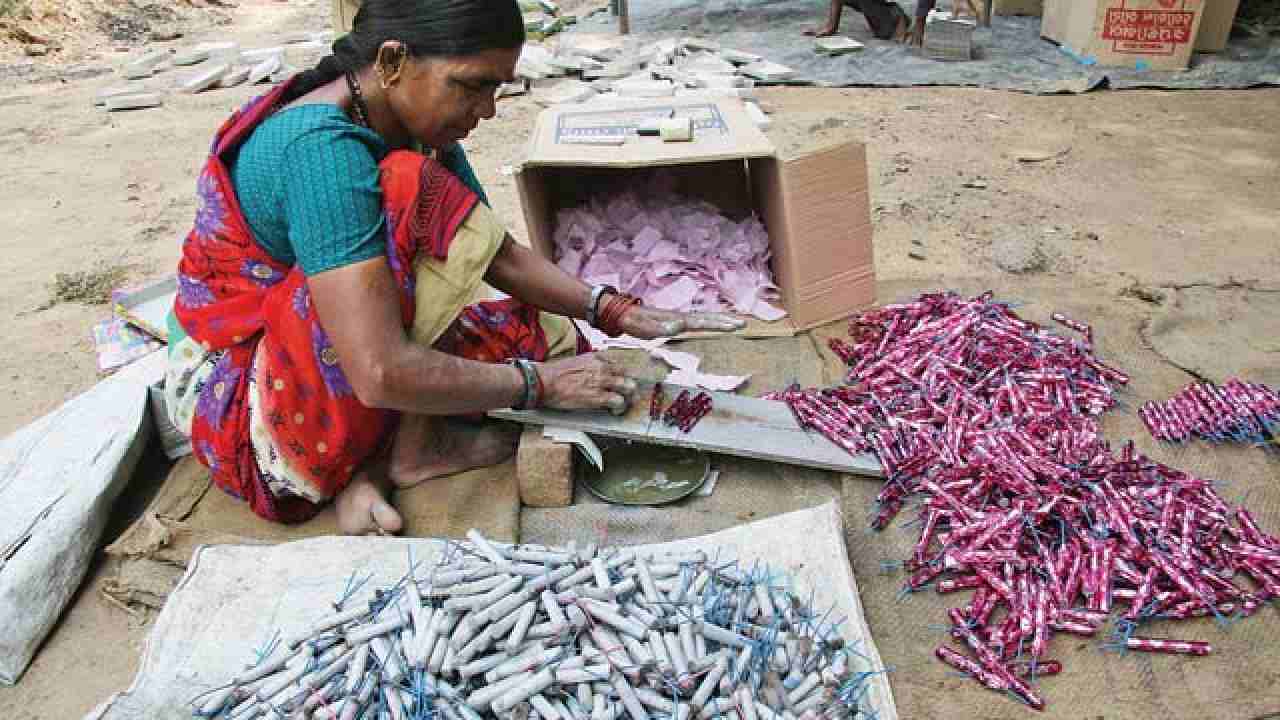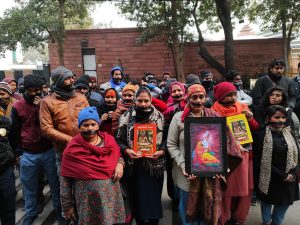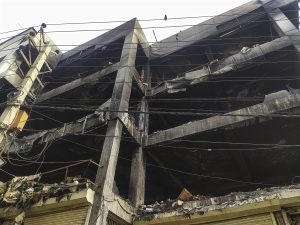In Poll-Bound Tamil Nadu, Labour Rights Of Women Workers Flouted

S. Rathinam (39) had escaped death by a whisker that afternoon.
On February 13, 2021, she, along with hundreds of others, had to run for their lives when a blast rocked the fireworks unit where they worked in Achankulam village, near Sivakasi in Virudhunagar district of southern Tamil Nadu. Up to 26 people, mostly women, were killed and several injured in the explosion.
“Everything happened in a flash,” recalled Rathinam. But as a worker in a fireworks unit in the Sivakasi region, this is not the first time she has seen death at such close quarters. It may not even be the last.
With the state readying for Assembly elections on April 6, the incident features regularly in campaign speeches. Opposition leader and head of the Dravida Munnetra Kazhagam M.K. Stalin accused the Edappadi K. Palaniswami government of ignoring the chronic problems of the district’s hazardous fireworks and safety matches industry: There were at least four explosions between February and March 2021 at various units. In the last decade, 204 incidents resulted in 298 deaths and injuries to 236, according to data provided by the Virudhunagar district administration.
Palaniswami has, in his election speeches, promised to formalise the sector if his party, the All India Anna Dravida Munnetra Kazhagam (AIADMK), is voted back to power.
However, no one, not even politicians, acknowledge a salient feature of these tragedies –the worst-affected are poorly-paid women workers like Rathinam who form the backbone of the fireworks industry. Up to 95% of the work in Sivakasi’s fireworks industry is manual, ranging from direct handling of chemicals to filling, assembling, labelling and packing crackers, and 77% of those doing these hazardous tasks are women, as per ‘Socio-economic Conditions of Women Workers in Match Industry’, a report published by the Ministry of Labour in 2014-15.
Tamil Nadu’s economic structures, educational system and social development initiatives have for decades ensured a higher female labour participation rate (30%) than India’s average (19%), as per the Periodic Labour Force Survey, 2018-19, the latest available data. Women in rural Tamil Nadu are more engaged in the workforce (35%) than urban (24%), and again these figures are higher than the national averages, 20% and 16%, respectively.
However, women from other industries in the state that also have a large female workforce (around 75-80%, according to union leaders) such as auto components, electronics and garments industries, also complained of being underpaid, overworked and deprived of basic labour rights, as we detail later.
For example, the medium- and small-scale factories located in the industrial corridor around Chennai employ women on contracts that allow for stagnant salaries and easy hiring and firing, we found in interviews with workers. And western Tamil Nadu’s garment factories have a history of hiring and wage practices that put women workers at a disadvantage, as we explain.
The common thread across the industries we investigated is the promise they hold of paid employment and financial and social mobility for women. But their employers keep the workforce young, vulnerable and without labour rights so that it remains manageable.
Women paid half men’s wages in Sivakasi
Sivakasi’s pyrotechnics industry grew out of the economic desperation of a rain-starved region with poor groundwater reserves and few options of agricultural employment. The first safety matches manufacturing factory came up here in the 1920s after two young local entrepreneurs, P. Ayya Nadar and his cousin, Shanmuga Nadar, went to Kolkata to understand how the safety matches industry worked. Later, the family also set up fireworks and pyrotechnic chemicals units in Sivakasi. Soon, printing and label-making factories came up to service these manufacturers.
Entire families started working for these units. “As a result, a culture of seeking non-farm work was pervasive, involving the whole family unit and reflected in high workforce participation rates. Even in the 1991 Census, while the overall ratio for Tamil Nadu was 44% of the population, it hovered around 60% in Sivakasi and adjoining blocks, pointing to the sizeable deployment of women and child labour to supplement family income,” said journalist Harish Damodaran in his book India’s New Capitalists: Caste, Business, and Industry in a Modern Nation.
Today, Sivakasi’s 1,070 medium and small-scale units account for nearly 90% of the country’s firecracker production. The industry directly employs 300,000 workers and through allied sectors, another 500,000.
After stringent laws were passed to curb its infamous use of child labour, Sivakasi’s factories switched to hiring mostly women workers. Women now constitute 74% of the total workforce employed in the safety matches industry in Tamil Nadu and Kerala, according to the 2014-15 labour ministry report. Tamil Nadu alone contributes about 75% of the country’s total safety matches output.
Women workers in Sivakasi’s fireworks industry are typically paid half the daily wages men get: A woman worker earns around Rs 300 as daily wage, very rarely Rs 500, but the men in her family–entire families are often engaged in this work–earn Rs 600-Rs 800, we found.
‘Work-sheds overcrowded in peak season’
Sivakasi’s work-sheds are particularly hazardous because of multiple violations of safety laws relating to leasing, number of workers, licensed use of chemicals and so on. Licenses for small fireworks are issued by the district revenue officer (DRO) and the Petroleum and Explosives Safety Organisation (PESO), a nodal agency that regulates the use of hazardous substances such as explosives, compressed gasses and petroleum, authorises the production of high-end, hazardous firecrackers that promise spectacular light and sound display.
The licenses granted to those who run fireworks units differ depending on the nature of work involved, the crackers produced and the ingredients used. For example, the rules specify the number of workers per room and the number of rooms required based on the volume of material.
“Only four people are permitted to work in a shed. But we have more than eight working in a shed in peak season,” said G. Shanthi (30), a worker in a unit in Sivakasi.
Workers told us that sheds are overcrowded and chemical pellets are dried in the sun and not in the shade (products with high sulphur content have to be dried before 8.30 a.m. to avert accidents). During the peak production season, manufacturing units sublease their premises to contractors to increase their output beyond the limit stipulated in their licenses. Investigations into the February explosion revealed that the premises had been sub-leased to five individuals, which is illegal.
The Indian Fireworks Manufacturers’ Association (TIFMA) admitted that some units flout safety rules. “The biggest cause for the accidents is definitely because of the unscrupulous leasing and subleasing by manufacturers. As an association, the maximum we have been able to do is warn such manufacturers. The government should interfere and take stringent action,” said T. Kannan, general secretary, TIFMA.
Licenses of 90 fireworks units have been suspended in the last two months in Virudhunagar for flouting safety norms, according to the members of TIFMA.
Workers in the industry also complained of chronic headaches, dizziness and ulcers due to high levels of exposure to manganese, said a study published in the International Journal of Environmental Engineering and Management. Those who work without masks or gloves, as is the case in many Sivakasi units, risked inhaling high concentrations of chromium, manganese and lead, all heavy metals which carry a risk of cancer due to long term exposure according to the International labour Organisation (ILO).
J.Kanagalakshmi, a 28-year-old factory worker from Kiliampatti near Sivakasi, said she had painful, irregular and heavy periods, which she attributed to the extreme heat and exposure to chemicals at her workplace. “Many women who are just in their forties have had to remove their uterus because of this. We are regularly advised during health checkups at our factory to eat fruits and jaggery. We cannot afford to buy all that. The factories should provide us,” she said.
‘I do 200 wicks a day for Rs 500’
Just like her parents, Shanthi earns a daily wage of Rs 300. But that is not a stable daily wage: It depends on the volume of work brought in by her contractor. She is a second-generation worker in a Sivakasi fireworks factory. Education could have given her and her younger sister a better life, she pointed out, but both were married to men from the same village and now, their entire families have been engaged in this work for over a decade.
Until a couple of years ago, Kanagalakshmi worked at a unit where her work involved filling small chemical tubes with mud for high-end fireworks that promise complex displays and sounds.
“I used to do around 200 wicks a day and earn Rs 500. But work under the contractor was uneven. Some days there was no work at all,” she said. She now works in a factory that only pays her Rs 300 as daily wage but the work is easier and she has access to a toilet, which she did not in her earlier job.
Eswari (32) is traumatised by the memory of an explosion at her former workplace that killed and maimed her friends and coworkers. She could not get herself to go to work several days after the tragedy. “What can I do? This is the only job I have done all my life. I don’t know any other work. I’m working hard, so that my kids get proper education and go for better jobs,” she said.
The women workers we interviewed in Sivakasi said that they were hoping that education would give their children a better life.
But families often have no escape route out of the industry that had once given the much-needed upward economic mobility to landless labourers and helped them navigate the feudal landowning system, observed Muniraj, an activist who has been advocating for the rights of workers after losing two of his family members in fire accidents. “Nothing has progressed in terms of their working conditions and many families continue to work in the sector for at least two or three generations,” he said.
It was only in December 2020 that the Tamil Nadu government set up a separate welfare board for the “unorganised” fireworks and safety matches industry, a longstanding demand of the workers. As an initial step, the board will ensure that 62,661 workers, a mere 12% of the industry’s workforce, who are already a part of the state’s Manual Workers Welfare Board will receive benefits. The government announced that the unorganised workers in fireworks industries will be encouraged to register free as members, as is the case with the other welfare boards in the state.
“Every year we keep running to the courts against the firecracker ban. Whoever forms the government in Tamil Nadu should ensure a permanent solution to this,” said Kannan.
As the chorus for “ban fireworks” grows louder each year with multiple court cases, women workers grow anxious about their survival. “From mere survival to finding paid employment, it just feels like we are always living on the edge,” said Shanthi.
The government needs to intervene on behalf of the workers, said Kannan of TIFMA. “Whether it is the central government or state government, nothing has been done for the welfare of the labourers in the fireworks industry that has about 75% of women in the workforce and generates an annual turnover of Rs. 2,500 crore,” he said Kannan. “Considering the hazardous nature of this work, the government should ensure factories strictly adhere to stipulated rules and provide necessary social security for workers.”
‘Manipulative’ contracts
As we said earlier, labour rights are violated even in other sectors where women dominate the workforce in Tamil Nadu. We take a brief look at two–the ancillary industry located in the outskirts of Chennai and the garments units in western Tamil Nadu.
Ruby (name changed to protect identity) is a contract worker in an auto components factory in Maraimalai Nagar that is categorised as an original equipment manufacturer (OEM). Ruby, whose earnings support her family, works in a production line that manufactures the wiring systems for steering wheels.
Workers in these units, 75% of whom are women–as we were told by multiple employees at OEMs–are recruited by third-party agencies that pay them salaries and are responsible for ensuring other benefits to contract employees working in these hubs. Women interviewed by BehanBox said their salaries were kept at low and at entry-level over years, there was no job security and no opportunities for growth. “As a trainee, I earned Rs 8,000; four years later, my salary is just Rs 10,000,” said Ruby.
Increasing contractualisation of India’s labour force is leading to a decline in wages, benefits and work conditions, and reduced accountability for companies even as they increase their profit, IndiaSpend had reported in March 2019.
‘Exploitative’ garments units
Largely concentrated in western Tamil Nadu–Coimbatore, Tiruppur, Erode, Namakkal, Salem, Karur and Dindigul districts–the state’s garments and textiles industry has a history of exploitative labour practices with complaints of low wages, overwork, physical and sexual violence, restriction on movement and denial of the right to form unions.
G Kokila, 20, started work at a spinning mill in Dindigul district of Tamil Nadu, soon after she finished secondary school, at a daily wage of Rs 230. Today, four years later, she earns Rs 300.
The industry was once known for its coercive Sumangali Scheme, where young unmarried girls were forced to work for lump-sum payments, ranging from 30,000 to Rs 1 lakh paid as compensation for wedding expenses. The women were never paid wages or any other benefits such as Provident Fund or Employees’ State Insurance.
These practices have been replaced by new ones that have only changed the nature of this exploitation, we found. Through schemes like Pradhan Mantri Kaushal Vikas Yojana and Deen Dayal Upadhyaya Grameen Kaushalya Yojana that are part of the Skill India initiative, many young women from within the state and elsewhere–Odisha, Assam, West Bengal and Bihar–are brought in to work at the spinning mills and garment factories of Tamil Nadu. “The kind of norms and methods that were existent in the 1980-90s as part of the [Sumangali] scheme has altered to accommodate more flexible approaches like recruiting 16- to 18-year-old girls and only retaining them for one or two years,” said S. Thivya of the Tamil Nadu Textile and Common Labour Union.
Srinivasan, a field worker at the Tamil Nadu Alliance, a coalition of civil society organisations that is working towards improving the conditions of workers in the textile sector, alleged that young girls were recruited as trainees and made to work extra shifts with no additional pay or overtime. “In most cases, the hostel wardens are in charge of their ATM cards in which salaries are credited,” he said.
The report is produced in collaboration with Indiaspend.
We believe everyone deserves equal access to accurate news. Support from our readers enables us to keep our journalism open and free for everyone, all over the world.




